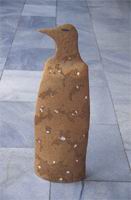Štefan Oriško
The sixteenth ceramic symposium took place in Lučenec during the summer. The symposium remained true to its main characteristics – work from the local ceramic factory near Lučenec, which was not designed for artistic production. Interest in this event came from both Slovakia and abroad. Six artists participated in this event. This fairly small team was differentiated by both the generations as well as opinions. After four weeks of endeavour, the final exhibition of the results of the symposium exhibited to the public in the Novohradské Museum and gallery in Lučenec seemed conservative. Helly Oestreicher (born in Karlove Vary in the former Czechoslovakia, 1936) has been devoted to discovering ceramics in vase and vessel form and their uses. Michel Kuipers (1949) represents a different line of contemporary Dutch and world ceramics – he searches for new functions in this artistic genre. He is known for his numerous implementations in architecture and public areas: the newest one – A Dream About Arcadia, decorates the Olympic Park in Athens. A similarly significant style can be found with the founder of modern Latvian ceramics – Peteris Martinsons (1931). He modelled large lion figures from local chamotte as a variation of one of his usual symposium topics. Local inspiration from the production factory and countryside can also be found in the installation of domestic participant Anna Horváthová (1953) – she created a clay countryside on an old modelling table taken from the factory. Gabriela Luptáková (1947), another one of the local symposium participants, started to create a series of female figures in the past. This year she focused on decorating using coloured clays and porcelain. Andrea Čepiššáková (1973) surprised her audience with many colours and decorations, which she transferred as her memory of her long-time Latin American stay. The participants also created a mutual work. This year it was a ceramic chess set, where the individual figures provided room for the author’s expressions within the limits of clarity of the overall whole.
